Wanting Yang
FAST-GSC: Fast and Adaptive Semantic Transmission for Generative Semantic Communication
Jul 22, 2024



Abstract:The rapidly evolving field of generative artificial intelligence technology has introduced innovative approaches for developing semantic communication (SemCom) frameworks, leading to the emergence of a new paradigm-generative SemCom (GSC). However, the complex processes involved in semantic extraction and generative inference may result in considerable latency in resource-constrained scenarios. To tackle these issues, we introduce a new GSC framework that involves fast and adaptive semantic transmission (FAST-GSC). This framework incorporates one innovative communication mechanism and two enhancement strategies at the transmitter and receiver, respectively. Aiming to reduce task latency, our communication mechanism enables fast semantic transmission by parallelizing the processes of semantic extraction at the transmitter and inference at the receiver. Preliminary evaluations indicate that while this mechanism effectively reduces task latency, it could potentially compromise task performance. To address this issue, we propose two additional methods for enhancement. First, at the transmitter, we employ reinforcement learning to discern the intrinsic temporal dependencies among the semantic units and design their extraction and transmission sequence accordingly. Second, at the receiver, we design a semantic difference calculation module and propose a sequential conditional denoising approach to alleviate the stringent immediacy requirement for the reception of semantic features. Extensive experiments demonstrate that our proposed architecture achieves a performance score comparable to the conventional GSC architecture while realizing a 52% reduction in residual task latency that extends beyond the fixed inference duration.
Harnessing the Power of AI-Generated Content for Semantic Communication
Apr 10, 2024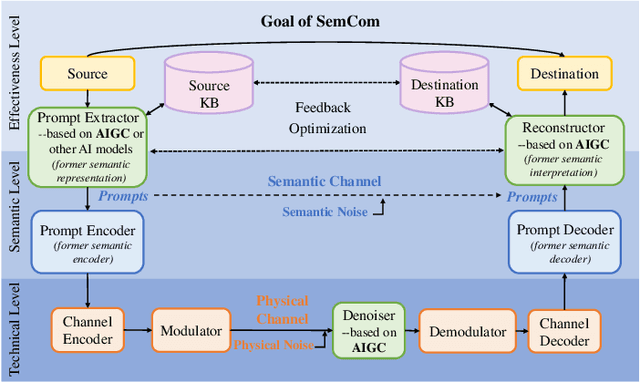
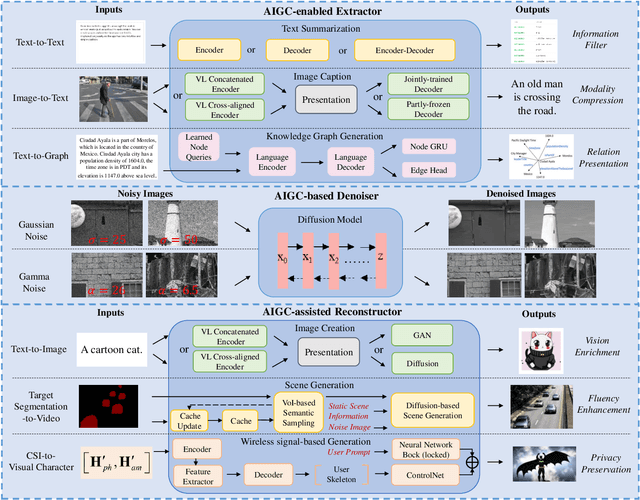
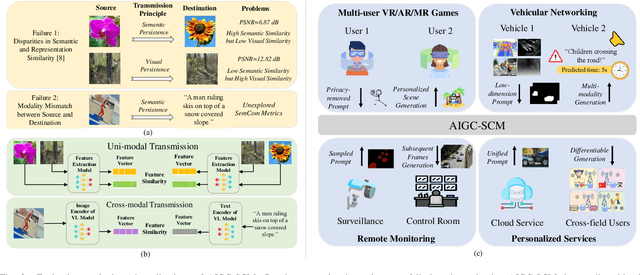
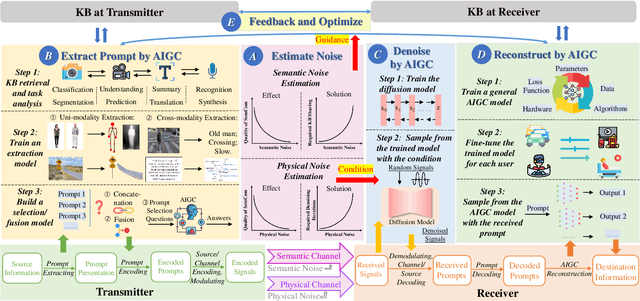
Abstract:Semantic Communication (SemCom) is envisaged as the next-generation paradigm to address challenges stemming from the conflicts between the increasing volume of transmission data and the scarcity of spectrum resources. However, existing SemCom systems face drawbacks, such as low explainability, modality rigidity, and inadequate reconstruction functionality. Recognizing the transformative capabilities of AI-generated content (AIGC) technologies in content generation, this paper explores a pioneering approach by integrating them into SemCom to address the aforementioned challenges. We employ a three-layer model to illustrate the proposed AIGC-assisted SemCom (AIGC-SCM) architecture, emphasizing its clear deviation from existing SemCom. Grounded in this model, we investigate various AIGC technologies with the potential to augment SemCom's performance. In alignment with SemCom's goal of conveying semantic meanings, we also introduce the new evaluation methods for our AIGC-SCM system. Subsequently, we explore communication scenarios where our proposed AIGC-SCM can realize its potential. For practical implementation, we construct a detailed integration workflow and conduct a case study in a virtual reality image transmission scenario. The results demonstrate our ability to maintain a high degree of alignment between the reconstructed content and the original source information, while substantially minimizing the data volume required for transmission. These findings pave the way for further enhancements in communication efficiency and the improvement of Quality of Service. At last, we present future directions for AIGC-SCM studies.
Agent-driven Generative Semantic Communication for Remote Surveillance
Apr 10, 2024Abstract:In the era of 6G, featuring compelling visions of intelligent transportation system, digital twins, remote surveillance is poised to become a ubiquitous practice. The substantial data volume and frequent updates present challenges in wireless networks. To address this, we propose a novel agent-driven generative semantic communication (A-GSC) framework based on reinforcement learning. In contrast to the existing research on semantic communication (SemCom), which mainly focuses on semantic compression or semantic sampling, we seamlessly cascade both together by jointly considering the intrinsic attributes of source information and the contextual information regarding the task. Notably, the introduction of the generative artificial intelligence (GAI) enables the independent design of semantic encoders and decoders. In this work, we develop an agent-assisted semantic encoder leveraging the knowledge based soft actor-critic algorithm, which can track the semantic changes, channel condition, and sampling intervals, so as to perform adaptive semantic sampling. Accordingly, we design a semantic decoder with both predictive and generative capabilities, which consists of two tailored modules. Moreover, the effectiveness of the designed models has been verified based on the dataset generated from CDNet2014, and the performance gain of the overall A-GSC framework in both energy saving and reconstruction accuracy have been demonstrated.
STAR-RIS-Assisted Privacy Protection in Semantic Communication System
Jun 22, 2023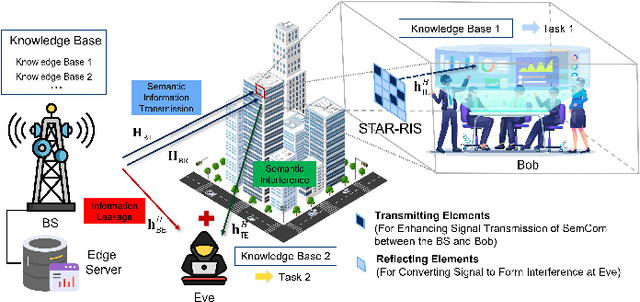
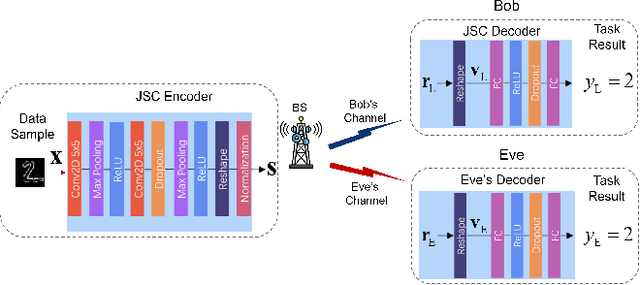
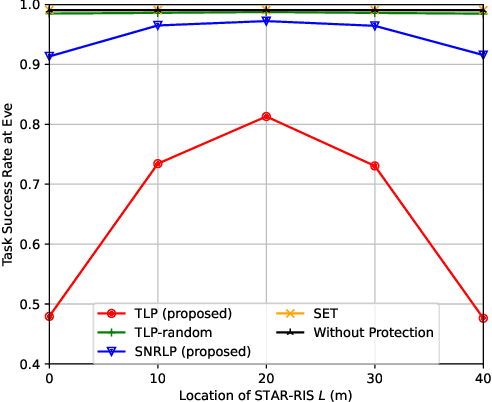
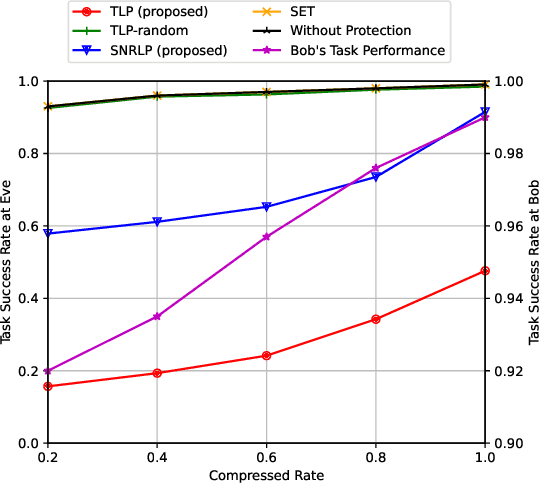
Abstract:Semantic communication (SemCom) has emerged as a promising architecture in the realm of intelligent communication paradigms. SemCom involves extracting and compressing the core information at the transmitter while enabling the receiver to interpret it based on established knowledge bases (KBs). This approach enhances communication efficiency greatly. However, the open nature of wireless transmission and the presence of homogeneous KBs among subscribers of identical data type pose a risk of privacy leakage in SemCom. To address this challenge, we propose to leverage the simultaneous transmitting and reflecting reconfigurable intelligent surface (STAR-RIS) to achieve privacy protection in a SemCom system. In this system, the STAR-RIS is utilized to enhance the signal transmission of the SemCom between a base station and a destination user, as well as to covert the signal to interference specifically for the eavesdropper (Eve). Simulation results demonstrate that our generated task-level disturbance outperforms other benchmarks in protecting SemCom privacy, as evidenced by the significantly lower task success rate achieved by Eve.
Semantic Communication Meets Edge Intelligence
Feb 14, 2022



Abstract:The development of emerging applications, such as autonomous transportation systems, are expected to result in an explosive growth in mobile data traffic. As the available spectrum resource becomes more and more scarce, there is a growing need for a paradigm shift from Shannon's Classical Information Theory (CIT) to semantic communication (SemCom). Specifically, the former adopts a "transmit-before-understanding" approach while the latter leverages artificial intelligence (AI) techniques to "understand-before-transmit", thereby alleviating bandwidth pressure by reducing the amount of data to be exchanged without negating the semantic effectiveness of the transmitted symbols. However, the semantic extraction (SE) procedure incurs costly computation and storage overheads. In this article, we introduce an edge-driven training, maintenance, and execution of SE. We further investigate how edge intelligence can be enhanced with SemCom through improving the generalization capabilities of intelligent agents at lower computation overheads and reducing the communication overhead of information exchange. Finally, we present a case study involving semantic-aware resource optimization for the wireless powered Internet of Things (IoT).
 Add to Chrome
Add to Chrome Add to Firefox
Add to Firefox Add to Edge
Add to Edge